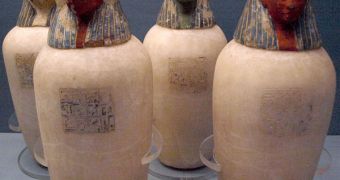The tombs of the pharaohs that were buried at Saqqara, an Egyptian archaeological site that never seizes to amaze archaeologists, has recently revealed other surprises, when a team of Japanese investigators has found four wooden sarcophagi, which date back more than 3,300 years, Egyptian authorities have announced on Thursday. Along with the relics, the scientists have also unearthed several other items, which are usually associated with the funeral rites. Saqqara is located just 25 kilometers (15 miles) south of Cairo.
The Supreme Council for Antiquities, the most competent authority in the field, has informed in a press release that researchers from the Waseda University in Tokyo have made the discovery in an area of the famous necropolis that has been eluding the attention of archaeologists for a long time.
Over the past years, digs have been focused on and around several large pyramids that were unearthed at the location. As such, the rest of the necropolis, whose exact size is still unknown, has evaded scrutiny. Still, huge breakthroughs are occasionally made in the area where not many scientists look.
Unfortunately, the newly-discovered artifacts do not have any mummies inside, because the tomb was raided in Ancient times by various groups of thieves. But they still bear the characteristic yellow and black markings on them, depicting some Egyptian gods. Also, the statement says, three Canopic jars, made entirely out of wood, have also been found, along with four boxes for ushabti figures.
In Egyptian mythology, these figures, made after the appearance of the dead person's slaves, were placed in the tomb so that the master could benefit from their use in the afterlife as well. Canopic jars were a very important part of the burial ceremony, as they contained the internal organs of the mummies, which were removed so that they wouldn't interfere with the action of the preservation agents. Sadly, only one of these artifacts, a ushabti box, has been found intact, but all of the figurines inside it were broken.
According to the statement, the sarcophagi were deposited in their final resting place sometime between the Ramesside period and the Late Dynastic Period, a timeline spanning from 1300 to 330 BC. Digs are scheduled to continue at Saqqara, as an estimated two thirds of Egyptian artifacts are believed to remain buried in the deserts throughout the country.

 14 DAY TRIAL //
14 DAY TRIAL //